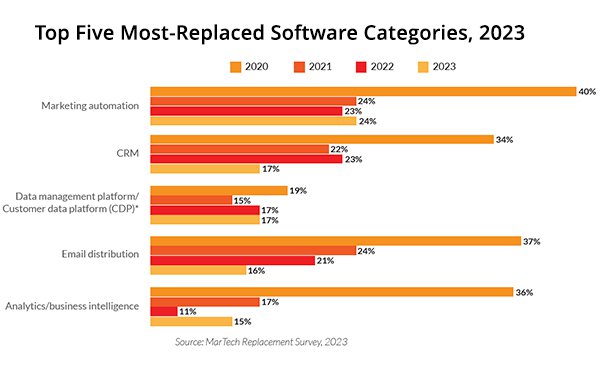Commentary
Software In, Software Out: The Email Systems Most Likely To Be Replaced
- by Ray Schultz , Columnist, April 15, 2024

Marketing automation software was switched more than other systems last year, judging by Email Marketing Platforms: A Marketer’s Guide, a study from MarTech.
Among the email marketers polled, 24% changed their automation software, roughly the same as the prior two years.
In addition, 17% changed their CRM program last year and the same percentage took on a new data management platform/customer data platform. Fresh email distribution programs were put in place by 16% and business intelligence software by 15%.
Why do companies make such changes? When deciding to replace homegrown applications, they cite these issues:
- Too expensive to maintain—29%
- Better features from SaaS software—43%
- Management decided we’re not a software company—14%
- Outdated code—5%
- Other—10%
advertisement
advertisement
The list is slightly different for commercial applications replacements:
- Better features—43%
- Reduce expenses—23%
- Better/easier integration—28%
- Other—5%
Of course, like everything, automation software was way more likely to be replaced in 2020—40% did so during that “turbulent year,” as the study describes it. And 34% replaced their CRM software, 37% their email distribution and 36% their analytics/business intelligence.
MarTech conducted in-depth interviews with vendors and industry experts in the fourth quarter of 2023, and also utilized third-party research.
In addition, MarTech analyzed these vendors without recommending any of them:
- ActiveCampaign
- Bloomreach
- Bravo
- Constant Contact
- Cordial
- Dotdigital
- Marigold
- MessageGears
- Oracle
- Salesforce
- Twilio SendGrid
- Zeta Global
- Do we have the right human resources in place?
- Does our customer data reside in disconnected silos throughout the organization?
- Do we have customer knowledge gaps that could be filled with second- and third-party data?
- Are we in compliance with GDRP, CAN-SPAM and other data privacy regulations put into place by U.S. states?
- Do we have C-level buy-in?
- Can we invest in staff training?
- To what extent do we need to share data and reports with non-email marketing staff?
- Have we established KPIs and put a system in place for tracking, measuring and reporting results?
- Do we have realistic expectations?


